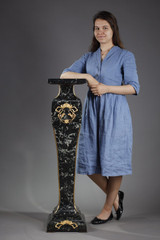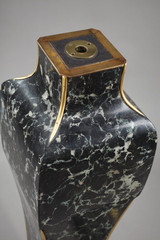An Art Nouveau period baluster-shaped pedestal table in scagliola, imitating green marble, with gilt bronze mounts. Featuring a rotating top, this pedestal is adorned at the corners with bronze fillets that accentuate its curved shape. The front is decorated with two motifs of vegetal knots with sinuous lines, one of which depicts a poppy flower. The whole rests on four small rectangular feet.
The Art Nouveau movement emerged at the end of the 19th century as a reaction against the numerous pastiches of the Louis XV and Louis XVI styles, which were very fashionable during the Second Empire. Seeking a completely new aesthetic, artists and artisans drew inspiration from nature and its sinuous forms to produce pieces in all areas of decorative arts and architecture.
Scagliola is a technique dating back to antiquity, commonly practiced in the 15th century, and which developed in Emilia-Romagna (Italy) due to the lack of marble quarries in the region. It competed with costly marble inlays. This decorative technique perfectly imitates marble and hardstone marquetry. Its smooth, glossy appearance rivals the most prestigious marbles. The material is composed of baked and ground selenite (a variety of gypsum), bone glue (animal glue), and natural pigments (oxides and minerals) to create a marble-like effect.
Tray dimensions: 28 cm x 28.5 cm (11.02 in x 11.22 in).
Art Nouveau period, circa 1900.
Dimensions: L: 30 cm, D: 30 cm, H: 111 cm.
Dimensions: W: 11.8 in, D: 11.8 in, H: 43.7 in.
Condition report: In good overall condition.
- Reference :
- 3235
- Width :
- 30 (cm)
- Height :
- 111 (cm)
- Depth :
- 30 (cm)
- Identify Exists:
- False










































